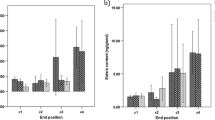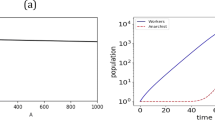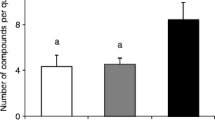Abstract
This paper develops a simple model for the movement of a non-volatile pheromone through a honey-bee hive. The model is specifically developed for a pheromone produced by the queen which is thought to regulate colony swarming. Although the model begins as a system of partial integro-differential equations, it is in the end reduced to a system of linear, first-order partial differential equations for the average pheromone level per worker, the pheromone level of the hive substrate, and the pheromone level of the queen. Analysis of this system shows that both colony size and hive area have independent effects on the average pheromone levels of the workers, but that worker congestion can have an even stronger effect on the pheromone distribution. These results establish a relationship between colony size, hive area, worker crowding, and queen-pheromone transmission.
Similar content being viewed by others
References
Gradshtyen, I. S. and I. M. Ryzhik (1980). Table of Integrals, Series, and Products, Academic Press, New York.
Jäger, E. and L. A. Segel (1992). On the ditribution of dominance in populations of social organisms. SIAM J. Appl. Math. 52, 1442–1468.
Naumann, K., M. L. Winston, K. N. Slessor, G. D. Prestwich and F. X. Webster (1991). Production and transmission of honey bee queen (Apis mellifera L) mandibular gland pheromone. Behav. Ecol. Sociobio. 29, 321.
Naumann, K., M. L. Winston, and K. N. Slessor (1993). Movement of honey bee (Apis mellifera L) queen mandibular gland pheromone in populous and unpopulous colonies. J. Insect Behav. 6, 211.
Seeley, T. D. (1979). Queen substance dispersal by messenger workers in honeybee colonies. Behav. Ecol. Sociobio. 5, 391.
Seeley, T. D. and R. D. Fell (1981). Queen substance production in the honeybee (Apis mellifera). J. Kansas Entomol. Soc. 54, 192.
Watmough, J. (1996). PhD thesis, University of British Columbia, Canada.
Watmough, J. (1997). A general model of pheromone transmission within honey bee hives. J. Theor. Bio. 189, 159–170.
Winston, M. L. (1987). The Biology of the Honeybee, Cambridge: Harvard University Press.
Winston, M. L. and O. R. Taylor (1980). Factors preceeding queen rearing in the Africanized honeybee (Apis mellifera). Insectes Sociaux 27, 289.
Winston, M. L., H. A. Higo, S. J. Colley, T. Pankiw, and K. N. Slessor (1991). The role of queen mandibular pheromone and colony congestion in honey bee (Apis mellifera L.) reproductive swarming (Hymenoptera: Apidae). J. Insect Behav. 4, 649.
Author information
Authors and Affiliations
Corresponding author
Rights and permissions
About this article
Cite this article
Watmough, J., Winston, M. & Slessor, K. Distinguishing the effects of dilution and restricted movement on the intra-nest transmission of honey-bee queen pheromones. Bull. Math. Biol. 60, 307–327 (1998). https://doi.org/10.1006/bulm.1997.0006
Received:
Accepted:
Issue Date:
DOI: https://doi.org/10.1006/bulm.1997.0006




